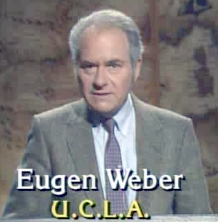 The glory that was Rome and its empire has been covered in television documentaries rather expansively. Yet the Eastern Empire that survived the fall of Rome in 476, and continued on for another 1,000 years as the Byzantine Empire, gets far less attention in American media. In 1990, the band They Might Be Giants released their album Flood, which contained a catchy cover of the song “Istanbul (Not Constantinople)“. The lyrics noted the city’s change of name under Turkish rule, but little else. A year earlier though, UCLA professor Eugen Weber used a simple lecture/b-roll format to give an in-depth look at the remarkable history of the Byzantines (and their capital city) in two episodes of his 52-part televised lecture series, The Western Tradition. First broadcast in 1989 on American public broadcasting through WGBH Boston, the series can now be streamed through The Annenberg Foundation’s Learner website. To mark the 25th anniversary of its debut, and the importance the series had in shaping viewer perceptions of the peoples and places of Western history, Camera In The Sun is revisiting The Western Tradition throughout 2014. And what better way to start… than in Late Antiquity, beginning with Weber’s intro to “Episode 15: The Byzantine Empire”:
The glory that was Rome and its empire has been covered in television documentaries rather expansively. Yet the Eastern Empire that survived the fall of Rome in 476, and continued on for another 1,000 years as the Byzantine Empire, gets far less attention in American media. In 1990, the band They Might Be Giants released their album Flood, which contained a catchy cover of the song “Istanbul (Not Constantinople)“. The lyrics noted the city’s change of name under Turkish rule, but little else. A year earlier though, UCLA professor Eugen Weber used a simple lecture/b-roll format to give an in-depth look at the remarkable history of the Byzantines (and their capital city) in two episodes of his 52-part televised lecture series, The Western Tradition. First broadcast in 1989 on American public broadcasting through WGBH Boston, the series can now be streamed through The Annenberg Foundation’s Learner website. To mark the 25th anniversary of its debut, and the importance the series had in shaping viewer perceptions of the peoples and places of Western history, Camera In The Sun is revisiting The Western Tradition throughout 2014. And what better way to start… than in Late Antiquity, beginning with Weber’s intro to “Episode 15: The Byzantine Empire”:
“They called it ‘The Second Rome.’ A great city astride Europe and Asia, and its vast empire — which would preserve Greco-Roman culture and transmit it to the West, when Rome itself lay in barbarian hands. The Byzantine Empire, this time on The Western Tradition…”

Byzantium. Constantinople. Istanbul. Three identities of a city whose strategic location along the narrow passage between the Black Sea and the Mediterranean (the Bosporus) made it a natural trading center, and whose geography was defensible enough that the emperor Constantine chose it as the capital of his Eastern Roman Empire in 330 — leaving the all-too-vulnerable Rome as the capital of the besieged Western Empire that would fall in 476. The city which bore his name boasted thick walls that became legendary for repelling repeated attacks, until a redirected Crusade broke that mystique in 1204, when the city was 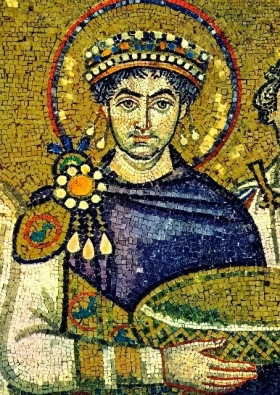 conquered and pillaged — but later restored to Byzantine rule in 1261. Finally in 1453, the army of Ottoman Sultan Mehmed II used massive canons to help breach the walls and end Constantinople’s Byzantine era long after it had become a shell of its former glory. My focus here will be Weber’s take on the men who ruled over that glory, managing the evolution of a 1,000-year empire’s culture.
conquered and pillaged — but later restored to Byzantine rule in 1261. Finally in 1453, the army of Ottoman Sultan Mehmed II used massive canons to help breach the walls and end Constantinople’s Byzantine era long after it had become a shell of its former glory. My focus here will be Weber’s take on the men who ruled over that glory, managing the evolution of a 1,000-year empire’s culture.
The lifespan of the Roman Empire is usually examined foremost through the reigns of its Caesars — with great attention to Julius, Augustus, Claudius, Marcus Aurelius, and Constantine. Yet only a few Byzantine rulers have anywhere close to the name recognition of their earlier Roman counterparts. Beyond Constantine, the most prominent of them is Justinian I — who took the throne in 527 and set about reclaiming vast swaths of conquered Roman territory. His general Belisarius reconquered the African regions from the Vandals with an army of 15,000, and Italy with only 8,000 — nearly doubling the size of the empire, and greatly enhancing Justinian’s legacy. But Weber adds more to the story of those conquests, noting that Justinian “exhausted the resources of Byzantium, while also ruining Italy’s economy and killing a large part of its population.” Moreover, Weber points out that Justinian’s successors were better off scaling back their holdings to focus on Anatolia and the Balkans, and how “it was no accident that the Byzantine Empire reached its high point when it became smaller and more defensible between the 8th and 12th centuries.”
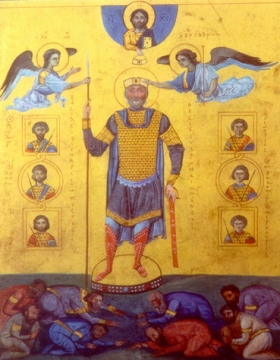 At the heart of this fluctuating empire was a city that weathered 1,000 years as the cultural heir to Empire-era Rome, or as Weber puts it: “Constantinople remained what Paris was, what New York is today: the foremost city of luxury, fashion and culture. Also the city of sin, corruption and material temptation.”
At the heart of this fluctuating empire was a city that weathered 1,000 years as the cultural heir to Empire-era Rome, or as Weber puts it: “Constantinople remained what Paris was, what New York is today: the foremost city of luxury, fashion and culture. Also the city of sin, corruption and material temptation.”
The man who ruled from Constantinople was not only emperor, but the defender of the Greek Orthodox faith, and the embodiment of the union between church and state. In addition to being the central source of all secular authority and law, he held final approval over all church decisions. This concentration of power led to some bizarre administrative predicaments when an emperor unexpectedly died without a nearby heir — as Weber recounts of Constantine’s passing in 337:
“The embalmed remains of the dead emperor continued to rule the empire through a whole summer, and autumn, and winter — with couriers reading their messages before it, ministers making reports to it, and courtiers seeking audience before it.”
Weber goes on to highlight how the men who succeeded Constantine as emperor composed a remarkably eclectic group. Because whether by election, or birth, or by force, the only real qualification to rule was to be a Greek Orthodox Christian. The Eastern Church’s realm had grown through its close connection with the expansive Byzantine government. When the church sent out missionaries to distant lands, they were also acting as ambassadors of the state. Thus, the church became the common bond that defined Byzantine nationality, and so the throne was open to pretty much anyone who lived within the church’s vast realm — be they wealthy or poor, educated or illiterate:
“Leo I in the 5th Century had been a butcher. People in Constantinople used to point out the stall where he and his wife had sold meat. Justin I in the 6th Century was a poor swineherd from the countryside who first appeared in the capital with bare feet and a pack on his back. And then one day his nephew left the family village to join him. His name was Justinian, and he became emperor in 527… Phocas, who ruled in the 7th Century, was a simple centurion. Leo III in the 8th Century was an odd job man. Basil I in the 9th Century was a peasant, probably a shepherd from Macedonia. And Michael IV in the 11th Century was a servant from Paphlagonia on the Black Sea.”
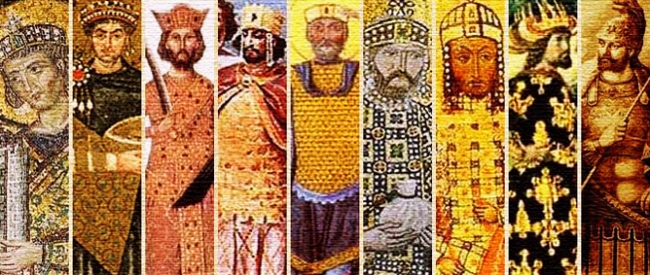
But Weber adds that once a emperor had taken the throne, there was no constitutional method to unseat him — except by a successful revolution. In fact, coups became so commonplace, that the act was essentially incorporated into Byzantine constitutional law. If you won your revolution, you were God’s chosen man in Constantinople. Lose, and you were a usurper, and could expect a painful death. Yet even those that won out were all too aware of the precedent for abbreviated reigns:
“Out of 88 emperors who ruled in Byzantium through 11 centuries, over 1/3 would be usurpers, and as many died in violent circumstances — poisoned, stabbed, strangled, beheaded, starved, tortured to death, or simply blinded, which was considered more humane.”
This threat of death-by-revolution had an overt effect on the emperor’s distance from his subjects, which became very apparent for those given a royal audience during the early turbulent centuries of the Byzantine Empire — when the emperor’s position was at its least secure. Weber recounts how a “spectacular megalomaniac kind of drama is devised. Both to enhance power, and to 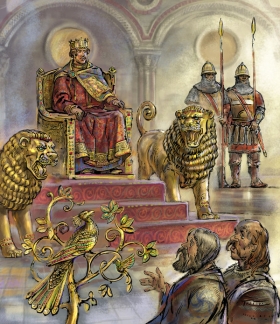 make up for the shortcomings in this power.” That drama’s expression was a critical bit of diplomacy for the Byzantines during the height of barbarian incursions into former-Roman territory, because as Weber points out, “the Byzantines and their emperors realized that diplomacy is cheaper than war. Because when it works, your enemies do your fighting for you. And even when it doesn’t work, it helps to buy time.” He paints a vivid picture of what a tribal chieftain could expect during an imperial audience:
make up for the shortcomings in this power.” That drama’s expression was a critical bit of diplomacy for the Byzantines during the height of barbarian incursions into former-Roman territory, because as Weber points out, “the Byzantines and their emperors realized that diplomacy is cheaper than war. Because when it works, your enemies do your fighting for you. And even when it doesn’t work, it helps to buy time.” He paints a vivid picture of what a tribal chieftain could expect during an imperial audience:
“He enters the octagonal room where this silent, stiff, completely motionless figure is seated on an elevated throne veiled by purple fabrics — purple being the imperial color, and forbidden to everybody else. The furniture of the room is very strange. There are golden lions, golden griffons, golden birds perched on golden trees, rather like a glorified kind of mechanical toystore gone wild. And all of this is set in motion by the chieftain’s entrance. The animals open their mouths, the birds open their beaks and sing, the griffons whistle, the lions roar and thrash their tails. And meanwhile, the visitor has to prostrate himself. And when he gets up, he cannot see either the emperor or the throne. Finally, he discovers that the throne has somehow risen way up, and the emperor is still sitting on it, stiff, painted — but now wearing another costume than the one he had apparently been wearing a moment before, and certainly too far away to hold a conversation. The man is not just impressed, he is befuddled. He is dominated by all this splendor.”
Such a spectacle makes the idea of Constantine’s ruling corpse a more-plausible prospect. But regardless of the means by which they psychologically dominated upstart tribes, the end result was a peaceful barbarian borderland for the empire, and the spread of the church — as Weber makes clear in his description of the pact our chieftain would be expected to make with the Byzantines:
“He agrees to fight for the Roman Christ and for the empire. He will be kept happy by presents, honors, subsidies. He may be given a Byzantine princess in marriage. He will certainly be sent a bishop who is subject to the Patriarch of Constantinople, and who will sustain imperial interests.”
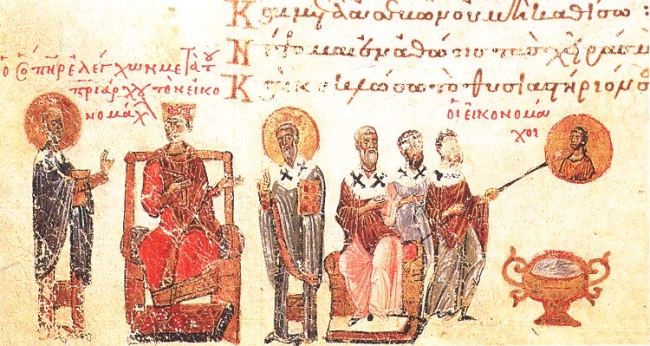
The form of Christianity that those bishops spread was one increasingly opposed to the popularity of icon worship, which characterized Christianity in the lands of the former Western Empire, and whose leaders there Weber tells us “regarded Eastern iconoclasm as sacrilege and heresy.” At one point, this became an intensely divisive 117-year-long issue — starting with Leo III’s 726 order for the destruction of all religious icons in the empire, and concluding in 843 when young Michael III‘s regent mother Theodora finally restored the veneration of icons. But the prevailing difference of opinion on icons between Western and Eastern branches of Christendom was such that it helped produce a schism in the faith that lasts to this day. Moreover, Weber notes that after the icon-smashing 8th century, Roman Popes stopped seeking support from the Byzantines to protect against barbarian aggression, and instead began cutting their own deals with the barbarians to aid their religious struggle against Greek Orthodox iconoclasm. This all served as background to the formal division of Eastern and Western Christianity in 1054, with the mutual excommunications of the Pope of Rome and Patriarch of 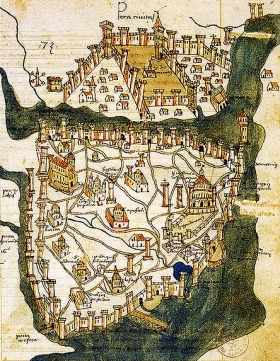 Constantinople. Yet regardless of how far apart the heirs to the Eastern and Western Roman Empires moved in matters of religion, politics and language, both sides could agree on the splendid grandeur of Constantinople — its great architectural achievements embodied by the massive Hagia Sophia basilica built under Justinian’s rule, which still stands today as a mosque in what is now Turkish Istanbul. Weber reiterated how such monuments made Constantinople “the city” of Late Antiquity:
Constantinople. Yet regardless of how far apart the heirs to the Eastern and Western Roman Empires moved in matters of religion, politics and language, both sides could agree on the splendid grandeur of Constantinople — its great architectural achievements embodied by the massive Hagia Sophia basilica built under Justinian’s rule, which still stands today as a mosque in what is now Turkish Istanbul. Weber reiterated how such monuments made Constantinople “the city” of Late Antiquity:
“The great marketplace, and the focus of the Christian and the trading world, Constantinople had paved streets than ran for miles. It was lined by arcades full of countless shops, with running water in every quarter, with a hippodrome greater than the Colosseum, and four gilded horses above the emperor’s box — which were later stolen by the Venetians to adorn the facade of their basilica.”
The 1204 sacking of the city by elements of the Fourth Crusade was due in part to the manipulation by Venice of the frenzied religious zeal of a crusader army raised to drive Muslims out of Jerusalem (via an invasion of Egypt). When the crusaders couldn’t come up with the money to pay for the fleet the Venetians had been commissioned to build and sail to Egypt, a repayment conquest of Zara in Dalmatia was undertaken — which led to Constantinople, when Byzantine prince Alexios IV Angelos promised to pay, outfit and transport the crusaders if his family was restored to the throne. His father Isaac II Angelos had been deposed, blinded and imprisoned in 1195, and Alexios IV would himself later be deposed and strangled to death after a short tenure as crusader-backed emperor. This all played out as Venice looked to dominate trade routes in the Eastern Mediterranean. Its involvement in the 1204 sacking occurred during a period of widely-diverging economic conditions between the East and West, which Weber expounds upon:
“When Constantinople was the wonder of Christendom, the West was backward. It didn’t have much to offer the east, in exchange for its silks and spices. A bit of iron and timber, slaves who were mostly kidnapped or captured Slavs (hence the term ‘slave’), and eventually woolen textiles which would improve 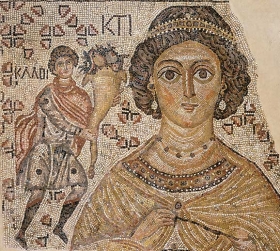 the balance of trade. But for a long time the Byzantines despised Westerners as barbarians, which they were — and as poor barbarians, which was worse. And the Westerners despised Byzantines as effeminate, devious and wicked. They ate fancy food, they wore fancy clothes, they washed far too much, and the women painted themselves, and the men hired other men to fight for them. So Westerners looked down on Byzantines, but they also envied their riches.”
the balance of trade. But for a long time the Byzantines despised Westerners as barbarians, which they were — and as poor barbarians, which was worse. And the Westerners despised Byzantines as effeminate, devious and wicked. They ate fancy food, they wore fancy clothes, they washed far too much, and the women painted themselves, and the men hired other men to fight for them. So Westerners looked down on Byzantines, but they also envied their riches.”
The crusader conquest, and the rise of Italian seafaring powers like Venice, marked the end of Byzantine trade dominance in the Eastern Mediterranean. Michael VIII Palaiologos booted the Latin Empire heirs of the crusaders from Constantinople in 1261, but his restored empire would never again be a regional power player. In fact, the uncertainty of life during this period inspired many Byzantines to take after Anthony the Hermit, and give up their material possessions to follow a religious life of poverty. For as Weber points out, “life was insecure and dangerous. And religious vocations, as well as outbreaks of violence and cruelty, were the natural consequence.” He describes the mindset of the average citizen during the years leading up to the 1453 Ottoman conquest:
“The life of the average East Roman was a life of care. They were afraid of the ruthless tax collector, of the arbitrary tyranny of the imperial governor, of the devouring land-hunger of the powerful, of the recurrent menace of barbarian invasion. It’s to the credit of the Byzantine world, to the credit of the tradition of Christian charity and social justice — which it often incorporated — that it realized this burden of fear and perennial danger, and tried to lighten it by building hospitals for the sick, for lepers, for the disabled. By building hostels for pilgrims, and strangers and old people. By building maternity homes for women, and refuges for abandoned children and the poor. Well-endowed institutions with elaborate charters telling just how they were to be administered.”
Yet no amount of money could prevent the advance of the Ottomans across Anatolia and other parts of what had once been Byzantium’s core territory. Cut off from Europe, the capital’s population had dwindled to around 50,000, with only 7,000 soldiers to defend them and the last of the Byzantine emperors, Constantine XI Palaiologos, as Mehmed II began his final assault on the battered walls of the siege-weary city:
“At dusk on May the 29th, 1453 the people of Constantinople made for the walls of the city, crying to the Virgin Mary for aid. Besieged for 50 days by 160,000 Turks, they didn’t have enough men left to man the long walls and to mend the breaches made by 130 canon, and a fleet of 250 ships. One hour after midnight, the Turkish assault began. By noon of May the 30th, Byzantium was dead after more than 1,000 years. In the West, however, its fall had already been discounted. Europe had other fish to fry.”
Yet the empire’s 1,000-year lifespan prior to its downfall had consequences for the Europeans that had turned their backs on the great city by the Bosporus. Weber closes his look at the Byzantines by quantifying their legacy for the Western European cultures which followed:
“The world of our own time ought to make it easier for us to understand the passions of the Byzantine world, the problems it faced, the fears under which it labored, and the simple feat of endurance it performed. Because finally, that’s what remains: the historic function of Constantinople as the outpost of Europe against the invading hordes of Asia. Under the shelter of that defense of its Eastern gateway, Western Europe could refashion its own life. And it’s hardly an exaggeration to say that the civilization of Western Europe is a byproduct of the will of the Byzantine Empire to survive.”